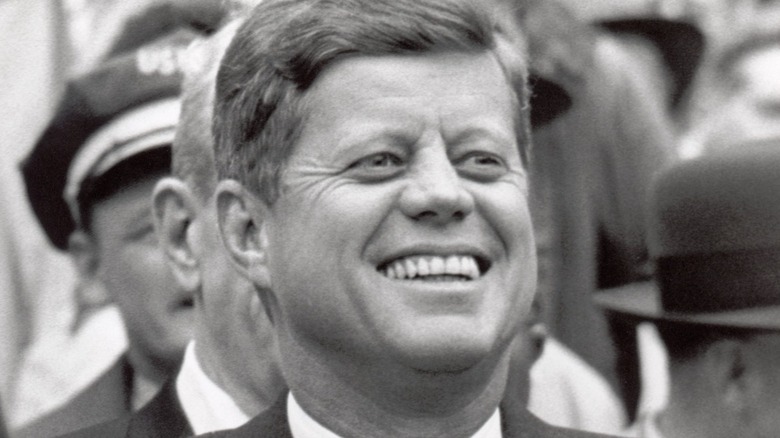
Robert Riger/Getty Images
Historians have typically considered the administration of President John F. Kennedy one of the better ones. According to a 2021 poll from C-SPAN, historians ranked JFK the eighth best president in history, slightly down from sixth in 2009.
It's not hard to see why. Kennedy has always been revered for his charisma, style, and strong leadership in times of crisis (via the Miller Center). His ability to get the limited test ban treaty done in the midst of the nuclear arms race with the Soviet Union was impressive. JFK's assassination by Lee Harvey Oswald cemented his legacy as one of the most beloved presidents of the 20th century.
However, not everything about the Kennedy administration was positive: his memory has been dogged by rumors about his private life, and his death has been the subject of bizarre conspiracies – and that's just the tip of the iceberg. These are the most questionable things about JFK's presidency.
JFK's flap with Nixon on the campaign trail
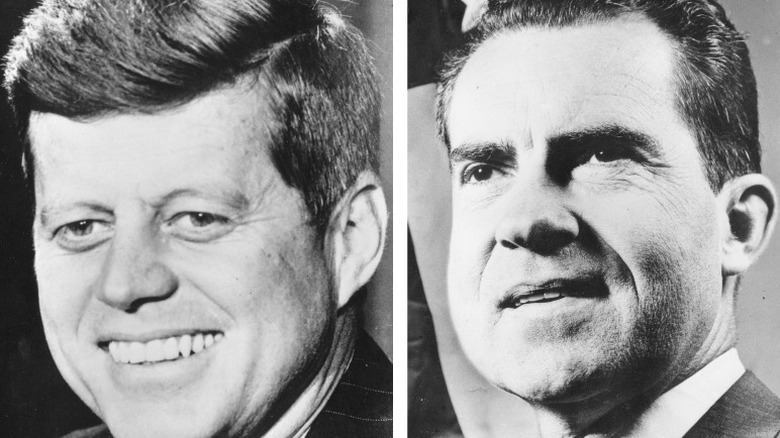
Keystone/Getty Images
The first questionable incident with the Kennedy administration actually occurred before JFK was even president. One of the most pressing matters for United States foreign policy in the early-1960s was the Cuban Revolution and the ascension of Fidel Castro to power. On the 1960 campaign trail, the head of the CIA, Allen Dulles, gave a briefing to Kennedy on the current state of U.S. foreign policy (via John Prados in "Safe for Democracy"). Dulles reportedly mentioned Cuba, but nothing specific about any covert plans for an invasion — which the Eisenhower administration was secretly planning with the CIA in what would become the Bay of Pigs invasion.
In their presidential debates, Kennedy's opponent Richard Nixon — the vice president at the time — accused Kennedy of being weak on fighting communism in Cuba. Kennedy responded by putting out a statement in the New York Times that specifically called for the Eisenhower administration to help indigenous Cuban forces trying to oust Castro. Nixon, claiming he was protecting the secret CIA operation's integrity, did not acknowledge the Eisenhower administration was already doing exactly that, and he called the idea "dangerously irresponsible."
Nixon was furious with Kennedy because he was convinced that JFK knew about the administration's planned secret operation and was trying to make Nixon look bad. Nixon blamed this flap for his eventual loss in the election; however, Dulles did not brief Kennedy about the Cuba operation, and Nixon was mistaken.
There have been claims the 1960 election was rigged
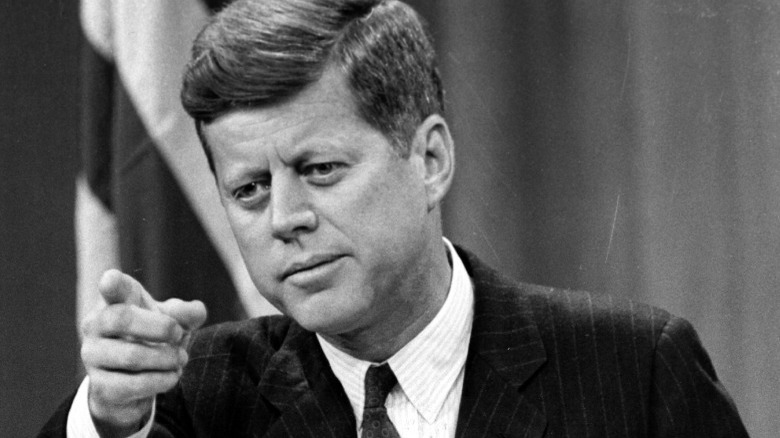
Keystone/Getty Images
The 1960 presidential election was a remarkably close contest. Though in the electoral college, it appears to be a blowout — with John F. Kennedy winning 303 votes to Richard Nixon's 219 — the popular vote was much closer (via UC Santa Barbara). The difference in the popular vote was barely 120,000 votes out of more than 68 million cast — or less than 0.5%.
Leading up to the election, the polls between Kennedy and Nixon were extremely close. Less than three months before, they were virtually tied in a Gallup poll, and on the eve of the election, they were within one percentage point of each other (via the Constitution Center). Immediately after Kennedy's victory, however, there were claims of malfeasance, particularly in Illinois and Texas. Texas and Illinois combined for 47 electoral college votes, which would have shifted the election to Nixon if he had taken both.
Accusations poured in against Democratic Chicago Mayor Richard Daley and Kennedy's running mate Lyndon B. Johnson, who was a Texas senator at the time. Nixon supporters claimed both states had engaged in ballot box stuffing and widespread voter fraud, and implicated them in "stealing" the election from Nixon. However, there has never been any reliable indication that voter fraud from either state was widespread or prominent, though historians argue as to whether or not some discrepancies occurred in Illinois. Nixon never formally challenged the results in Congress or court.
The massive failure at the Bay of Pigs
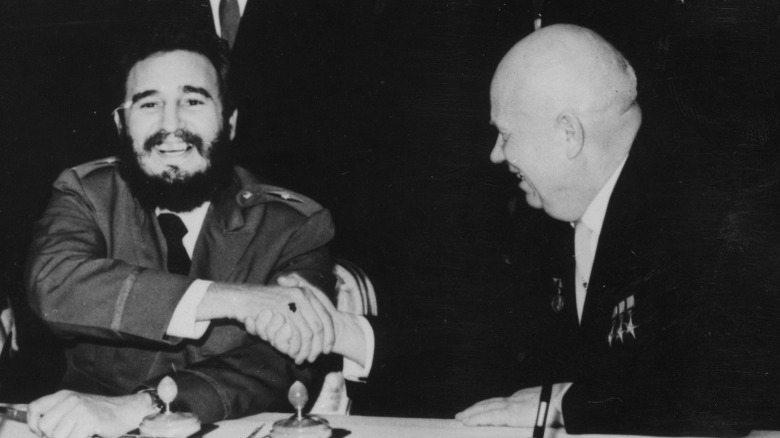
Keystone/Getty Images
In 1959, Fidel Castro took power in Cuba. He was backed by a revolutionary army and quickly took control of the Cuban government (via the CIA). However, Castro soon drew the ire of Washington by drawing close to the Soviet Union's communist orbit, entering into contracts for Soviet oil, and publicly announcing their comradeship. The Eisenhower administration reacted to the socialist and communist overtures of Castro by approving a CIA operation to remove him from power. The plan was to recruit Cuban exiles who had fled to Miami after the revolution and train them into paramilitaries, before sending them back to the Bay of Pigs in Cuba to oust the Castro government and take control.
After John F. Kennedy became president, he authorized the invasion to continue, and it was a complete disaster (via the JFK Library). Over 100 U.S.-trained Cuban paramilitaries were killed by the Cuban Army, and nearly 1,200 were captured. Castro remained in power and an antagonist against the U.S. for decades, and the Kennedy administration was thoroughly embarrassed less than four months into the presidency.
Historians have laid much of the blame for the Bay of Pigs on decisions made by JFK. They mainly point to his insistence on starting the operation at night, his refusal to allow for a second round of bombing, and his refusal to allow the Navy to help the Cuban forces (via John Prados in "Safe for Democracy").
The CIA tried to assassinate Fidel Castro under JFK
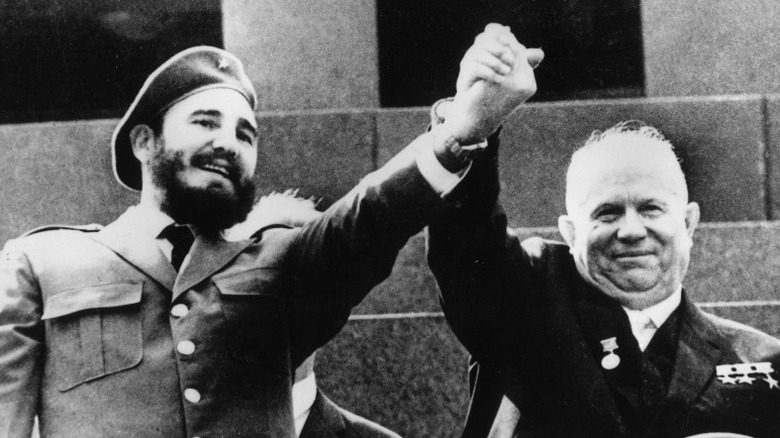
Hulton Archive/Getty Images
After the Bay of Pigs invasion failed, the Kennedy administration was still looking to remove Fidel Castro from power in Cuba (per PBS). Less than a year later, in January 1962, the Kennedy administration initiated "Operation Mongoose." Mongoose was a plot to remove Castro from power once and for all, and JFK's brother Robert Kennedy, the Attorney General at the time, hand-picked legendary CIA agent Edward Lansdale to plan it.
However, Lansdale was not the only CIA agent working on the job. Another man, William Harvey, was also a senior operative at the CIA, and he started to work on the project after being assigned by the former head of the clandestine service, Richard Bissell (via Lawrence Freedman in "Kennedy's Wars"). After struggling to make any headway for months, Harvey instead decided on a new tactic: using the mafia to assassinate Castro.
Harvey got in contact with mobsters Sam Giancana and Johnny Roselli, giving them poison pills to give to Castro in Cuba, but they failed to carry out the hit. Another assassination attempt under the JFK administration was a failed plot to deliver Castro a scuba suit infected with fungus and tuberculosis bacillus (via John Prados in "Safe for Democracy"). The suit was never delivered. After JFK's assassination in November 1963, the new president, Lyndon Johnson, gradually shut Mongoose down from May 1964 on (via John Prados).
The dramatic escalation of the Vietnam War
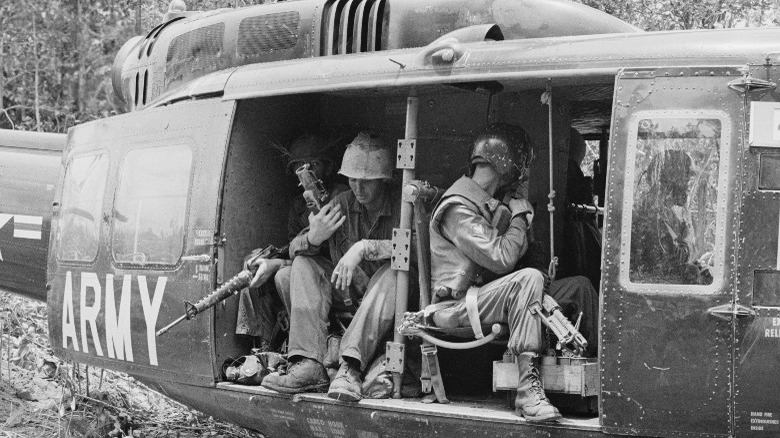
Michael Ochs Archives/Getty Images
One of the biggest foreign policy issues that JFK inherited from the Eisenhower administration was a growing financial and military commitment to the fledgling Republic of Vietnam. Previously, when he was a congressman in the House and Senate in the early-1960s, Kennedy had gone on record against any U.S. engagement in Vietnam (via Ronald E. Powaski in "The Cold War: The United States and the Soviet Union, 1917-1991"). During the First Indochina War between the Viet Minh and the French, he called the prospect of U.S. military aid to the French "dangerously futile and self-destructive."
However, by the time he was on the campaign trail in 1960, Kennedy was singing a different tune. Worried about Chinese Premier Mao Zedong's growing communist influence in Asia, JFK now favored much more aggressive tactics in Vietnam. He initiated a counterinsurgency strategy to combat the Viet Cong's use of guerilla warfare and started to allow the direct participation of U.S. soldiers in combat against the communists.
When Eisenhower left office in January 1961, there were only 700 advisors in the country. Yet, within four months on the job, JFK had sent another 500 Special Forces troops and military personnel to Vietnam, and within two years, he sent another 10,000 advisors on the way (via the JFK Library). By the time JFK was assassinated, there were roughly 16,700 U.S. advisors in the country, 16,000 more than in 1960, with events swiftly escalating.
JFK supported the assassination of Ngo Dinh Diem
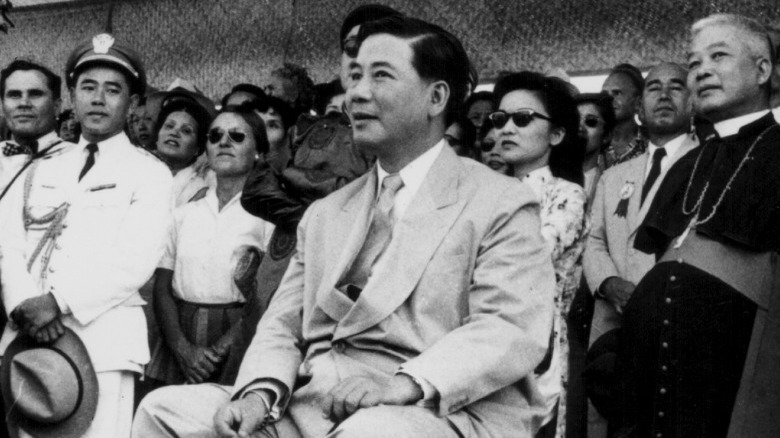
Keystone/Getty Images
While the conflict in Vietnam was escalating during the year 1963, some of the most cataclysmic events of the entire war took place. That spring, CIA agent Lucien Conein had gone into South Vietnam to spy undercover (via Tim Weiner in "Legacy of Ashes"). In May, he went to the former provincial capital of Hue to see the celebrations surrounding the Buddha's 2,527th birthday. However, while the celebrations were taking place, South Vietnamese soldiers and police officers killed and assaulted several Buddhist worshippers.
In protest, one Buddhist Monk, Quang Duc, doused himself in gasoline and immolated his body in front of the entire world. However, South Vietnamese President Ngo Dinh Diem (pictured above) continued to escalate his government's war on the Buddhists, and his forces started to openly kill women and children in their pagodas. Soon, the Kennedy administration started to secretly discuss plans to remove Diem from power.
In late August, Kennedy approved a cable recommending action, and on the 26th, the Ambassador to South Vietnam cabled back to Kennedy that "We are launched on a course from which there is no turning back: the overthrow of the Diem government." Vietnamese generals assassinated Diem in early November, with $40,000 in backing from the CIA (via John Prados in "Safe for Democracy"). Kennedy regretted the decision in the aftermath, immediately expressing dismay and disgust. However, without his support, it likely would not have happened in the first place.
His administration's use of the CIA
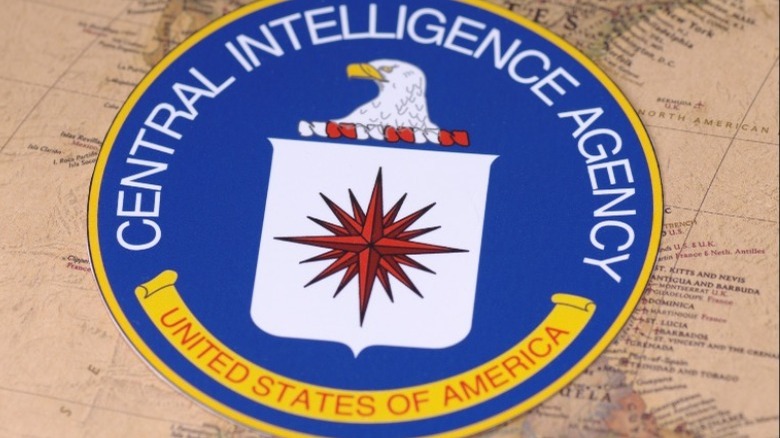
g0d4ather/Shutterstock
When John Kennedy took over the presidency from Dwight Eisenhower, he initiated quite a change in the CIA. It took some time, because, at first, he was so upset with them over their handling of the Bay of Pigs crisis that he wanted nothing more to do with them. However, he quickly changed his mind and started to supercharge their activities (via Tim Weiner's "Legacy of Ashes").
Whereas Eisenhower's administration had launched about 170 CIA operations during the entire two-term presidency, Kennedy initiated nearly as many, 163, in less than one term. This meant the CIA was conducting operations at double the rate under Kennedy compared to Eisenhower, including the aforementioned plots against Fidel Castro.
Much of this was carried out under the supervision of John McCone, who took over as the Director of the CIA after Allen Dulles departed following the Bay of Pigs disaster. Initially, JFK considered putting in his brother Robert Kennedy as the director but thought better of it for McCone, a former Eisenhower appointee. According to John Prados in "Safe for Democracy," not only did the CIA authorize 163 missions during JFK's tenure, but they had plans approved for nearly 400 more. NSA Director McGeorge Bundy, one of Kennedy's closest colleagues, has since noted how much pressure the administration started to exert over the CIA for increased covert missions.
JFK's embarrassing summit with Nikita Khrushchev
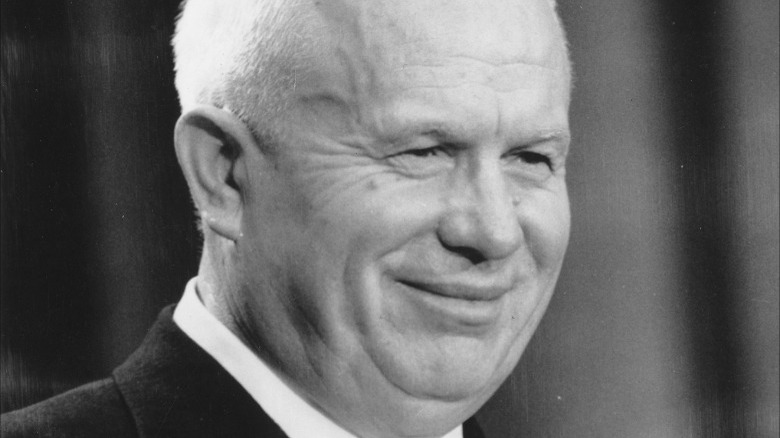
Keystone/Getty Images
The first six months of John Kennedy's presidency were about as dreadful as you can get. First, election rigging accusations clouded his initial victory, then he presided over the disastrous Bay of Pigs invasion in April. A month and a half later, in June, at his first summit with the Premier of the Soviet Union, Nikita Khrushchev, things again went poorly. Khrushchev, who was 67 at the time and had been a Bolshevik since the Russian Revolution (per History), did not respect the 44-year-old Kennedy or take him seriously (via History).
Khrushchev compared JFK negatively to his predecessor, Dwight Eisenhower, and considered him immature. Kennedy, eager to prove himself to the veteran hard-line communist, tried to debate Khrushchev on issues like Marxism and imperialism, but that only served to prove his own ineptitude and inexperience.
At one point, Kennedy even told Khrushchev he considered there to be rough parity between the Western European forces, like NATO, and the Sino-Soviet Alliance in Asia. This shocked Kennedy's aides that he would make such an assertion, while Khrushchev was thrilled with getting an American president to actually admit he considered the USSR military equals. After the summit, Kennedy knew he was a beaten man. He referred to the meetings with Khrushchev as the "Worst thing in my life," remarking that "he savaged me."
The Berlin Crisis
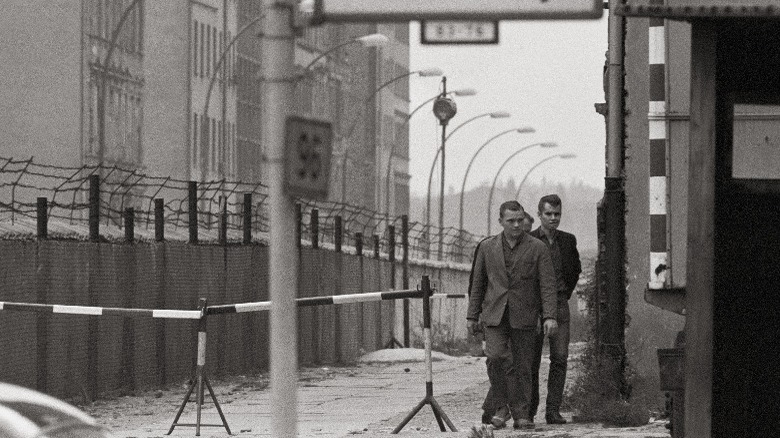
Brandstaetter Images/Getty Images
When WWII ended, one of the biggest questions for the Allies was how to administer newly occupied Germany. They decided to split the country into four zones, with a victorious ally — the United States, France, Great Britain, and the Soviet Union — each taking responsibility for one zone (via Neil Carmichael and Brewer Thompson in Prologue Magazine). The Soviets also wanted the other allies to vacate Berlin, which was in the Soviet sector, and tensions increased when the West balked.
In November 1958, Soviet Premier Nikita Khrushchev gave a speech demanding the Western allies immediately leave Berlin and pull out all of their personnel and equipment within six months (via the State Department's Office of the Historian). However, negotiations between Khrushchev and the Eisenhower administration broke down over the U-2 spy plane scandal in 1960, and Khrushchev decided to wait for the next presidential administration before renewing talks. At the Vienna Summit with Kennedy in 1961, the Soviet leader again gave the U.S. six months to leave Berlin. Kennedy responded by sending 1,500 troops to the German capital via the Autobahn and called up 150,000 army reservists (via Ronald Powaski in "The Cold War").
Then, on August 13, 1961, the East German government started to erect the now infamous Berlin Wall, separating East and West Berlin (via the Office of the Historian). Eventually, the wall became reinforced with concrete and stood as a symbol of the Cold War until its destruction in 1989.
The Checkpoint Charlie standoff
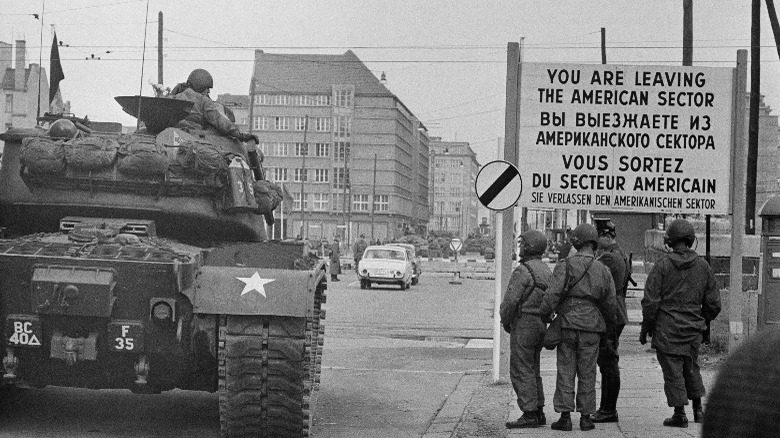
Express Newspapers/Getty Images
After the erection of the Berlin Wall in August 1961, tensions started to seriously boil between the United States and the Soviet Union. Later in the month, in response to the Kennedy administration's continued buildup of nuclear weapons, Soviet Premier Nikita Khrushchev publicly announced the resumption of open-air nuclear weapons testing, ending a two-and-a-half-year moratorium (via Ronald Powaski in "The Cold War"). They conducted nearly a nuclear test a day for the next two months, including exploding the Tsar Bomba, the largest nuclear explosion to ever be recorded. That September, Kennedy responded by resuming the U.S.'s dormant nuclear testing program.
Back in Berlin, temperatures were getting even hotter. In late October, at Checkpoint Charlie — one of the authorized crossing areas of the Soviet-U.S. border in Berlin, Germany — a dispute broke out over the search of U.S. diplomats and their travel documents (via the State Department's Office of the Historian). The Kennedy administration responded by mobilizing several U.S. Army tanks to face their gun barrels towards the East German side.
The Soviets responded by stationing their own tanks to face directly at the U.S. tanks, and everyone was locked and loaded, waiting for a confrontation. Thankfully, however, cooler heads prevailed. Kennedy reached out to Khrushchev through secret back channels, and the two agreed to both remove their tanks from Checkpoint Charlie, ending the threat of escalation.
JFK initiated the overthrow of Guyanese leader Cheddi Jagan
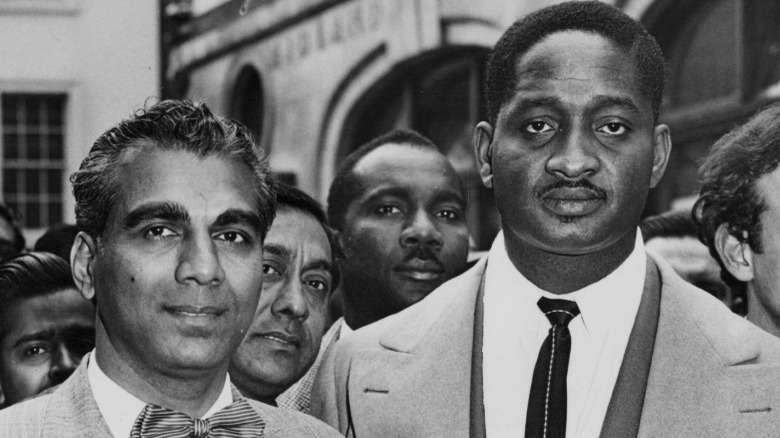
Central Press/Getty Images
In August of 1962, President John Kennedy's attention was focused on British Guiana, a small country in northern South America. Guiana had been under the control of Great Britain since the late 18th century and had only recently been allowed just nominal independence (via John Prados in "Safe for Democracy"). However, when the British allowed open elections for the first time in the 1950s, the winner, Cheddi Jagan (above left), was immediately labeled a communist and thrown in jail.
He was released a year later, and in the 1961 elections, Jagan's political party won 75% of the seats in the Guyanese assembly, and he was elected as the new Prime Minister. Almost immediately, Kennedy and the Director of the CIA, John McCone, started to discuss possibilities for removing Jagan from office due to his perceived communist leanings (via Tim Weiner in "Legacy of Ashes"). Jagan visited the White House that October and tried to convince Washington that he was not aligned with the Soviet Union. However, JFK refused to listen, and instead, he initiated a $2 million program for Jagan's overthrow the following August.
Throughout 1963 the CIA started to put their backing behind Jagan's political opponent, Forbes Burnham (above right, via John Prados). Kennedy was assassinated in November 1963 before any action happened, but the CIA, with British support, was able to push Jagan from power in 1964 under JFK's successor Lyndon B. Johnson.
His failed Alliance for Progress
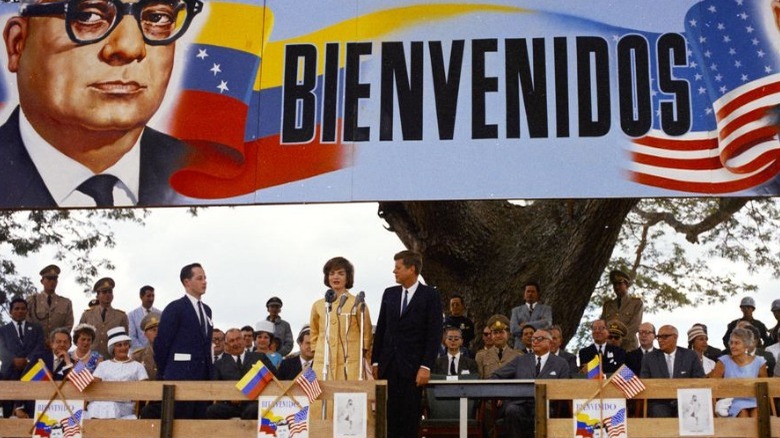
When JFK became president in January 1961, the issue of communism in Latin America instantly became one of his top priorities. The recent ascensions of Fidel Castro and Cheddi Jagan to power in Latin American countries showed that communism had invaded the western hemisphere, and Kennedy was determined to stop it from spreading. As such, in mid-March 1961, Kennedy announced the creation of the Alliance for Progress in Latin America (via Ronald Powaski in "The Cold War"). The purpose of the alliance was to fight against inequality and poverty in Latin America by creating programs to help diminish the amount of illiteracy and improve public health.
That August, Kennedy and his wife Jaqueline traveled to Uruguay to inaugurate the Alliance for Progress in Punta del Este (via the JFK Library). Unfortunately, the Alliance was hampered from the beginning. Federal funding, originally pledged at $10 billion over 10 years, was partly spent on creating paramilitary armies to fight communism, and never reached even close to the levels of the Marshall Plan in Europe.
Though there were some mild improvements to housing, education, and public health, overall, the Alliance was a disaster. Per Powaski, economic growth slumped below anticipated levels, unemployment increased, and no less than six military coups occurred in Latin America during Kennedy's presidency. Rapid population growth mitigated many of the improvements made to poverty and public health, and most Latin American leaders feared Washington far more than they did communism. Hardly progress.
His initial handling of the Cuban Missile Crisis
For many Americans living during the Cold War, the 1962 Cuban Missile Crisis was one of the scariest points of their entire lives. That October, the Kennedy administration announced they had discovered the Soviet Union was moving nuclear missiles onto the island of Cuba, barely 90 miles away from the coast of Florida (via History).
In response, Kennedy immediately instituted a blockade around Cuba and issued an ultimatum: remove the missiles or risk nuclear war. When a U.S. reconnaissance plane was shot down over Cuba on October 27, war seemed inevitable. However, at the last minute, Kennedy and Nikita Khrushchev agreed on a compromise to remove the weapons, and war was avoided. Normally, JFK gets very high marks for his handling of the crisis, but what most people do not realize is that the Kennedy administration actually had information about the nuclear weapons a month and a half earlier.
Per Tim Weiner in "Legacy of Ashes," JFK first became aware of the sites after a spy plane photographed them on August 29. Yet when informed, he told his aides to bury the report because he was worried about a scandal so close to the midterm elections. After a U-2 spy plane was downed over China weeks later, Kennedy grounded all U-2 flights over Cuba, and the Soviets moved 99 nuclear missiles in on October 4 without the U.S. knowing. When U-2 flights restarted, the missiles were revealed, kicking off the crisis.
His lax foreign policy on apartheid in South Africa
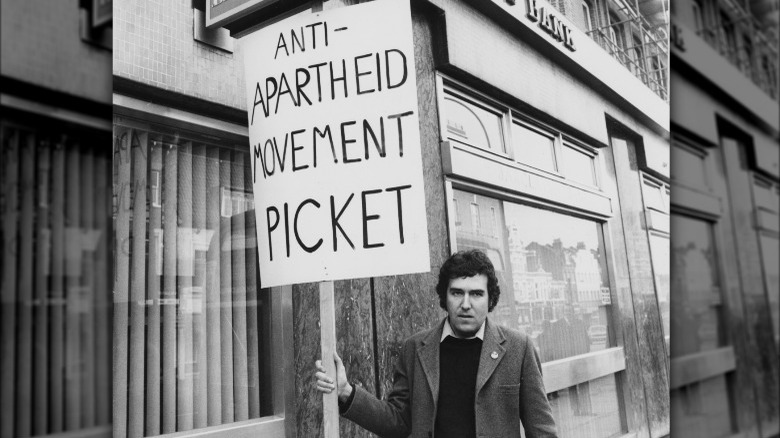
Gary Weaser/Getty Images
While JFK certainly had his hands full dealing with problems in Latin America, his policies towards Africa offered him little respite. While campaigning against Vice President Richard Nixon in 1960, Kennedy criticized the Eisenhower administration's attitude towards Africa (via Ronald Powaski in "The Cold War"). However, when he took over in early 1961, there was a strong continuity between the two administration's Africa policies.
Kennedy was just as concerned with the rise and spread of communism in Africa as he was in Vietnam, especially after the Soviet Union started to gain a foothold in the northeast. Kennedy began to offer financial incentives to neutral African leaders to get them to ally with the U.S. over the Soviet Union but did little to champion true African nationalism and independence.
His policies in South Africa were even worse. Apartheid and segregation had been endemic in the country since the early 20th century, and in the 1950s, they were legally enshrined into law by the racist Afrikaner government (via History). The Kennedy administration did basically nothing to end Afrikaner rule in South Africa and only engaged in symbolic efforts to protest the domination of white supremacy (per Powaski). He refused to back any economic sanctions and continued to be reliant on the country's precious minerals for trade. JFK did finally acquiesce to signing an arms embargo against them, but he also continued to sell them spare military parts — effectively undermining it.
JFK's relationship with Mobutu Sese Seko
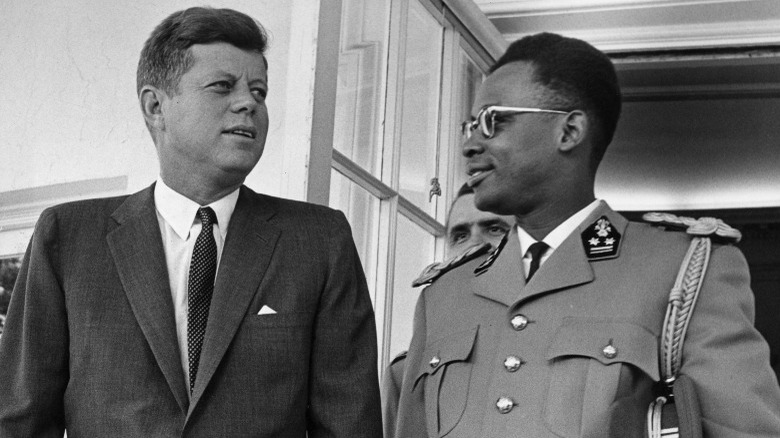
Keystone/Getty Images
Another area of Africa that drew the close attention of the Kennedy administration was the "Congo Crisis," which had actually begun during the previous administration in 1960. According to the State Department's Office of the Historian, throughout 1960, the Congolese were preparing for their official independence from Belgium to the high hopes of the Eisenhower administration. However, that June, a mutiny broke out, pitting Congolese and Belgium troops against each other, and soon the entire country was engulfed in chaos.
In the midst of infighting in the new Congolese government, a Colonel in the army, Joseph Mobutu (pictured above), initiated a coup d'etat and seized power. The new Kennedy administration immediately supported Mobutu and his bid to create a stable and pro-Western Congo, gave him huge funds, and signed bilateral military agreements. Kennedy even arranged for Mobutu to attend parachute training school at Ft. Benning, Georgia, as a testament to their relationship (via Odd Arne Westad in "The Global Cold War").
Mobutu, who renamed Congo to Zaire and started to call himself Mobuto Sese Seko, ruled the country for the next three decades until being deposed in 1997 (via Britannica). His government was incredibly unstable, and he constantly faced attempted coups and rebellions. He is also noted for his massive corruption, gaining a massive personal fortune while presiding over an endemically poor and economically stagnant country. Yet, without Kennedy's support, he might never have gained power in the 1960s.
His secret recording system in the White House
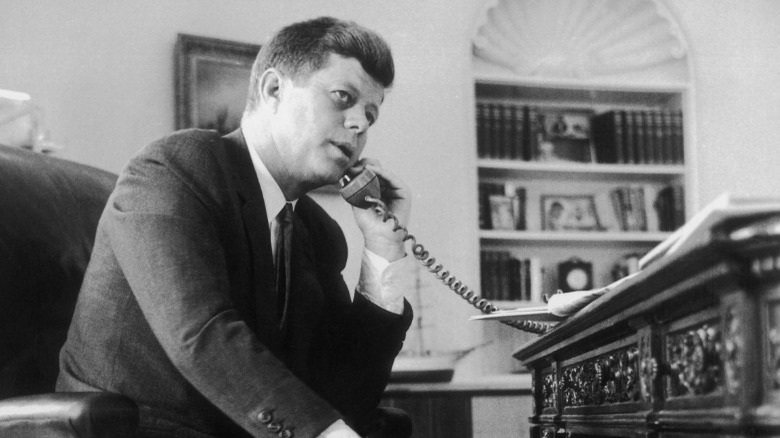
Evening Standard/Getty Images
It might sound surprising at first, but from Franklin D. Roosevelt in the 1930s all the way to Richard Nixon in the 1970s, every single American president had at some point allowed for secret recordings of their meetings (via the JFK Library). During his time in office, John Kennedy was one of the most prolific secret tapers of all. In Spring 1962, Secret Service agent Robert Bouck installed JFK's secret recording system in both the Oval Office and Cabinet Room.
JFK died before ever having to answer about the secret taping system, which was only publicly revealed in 1973 during the hearings on the Watergate scandal. His secretary, Evelyn Lincoln, has suggested that it was possibly installed for the innocent purpose of keeping accurate records. She also proposed that Kennedy had it put in because his advisors had previously agreed to things in private only to publicly claim the opposite, and JFK wanted to be able to hold them accountable.
Regardless of the reason, Kennedy and various Secret Service agents were the only ones with access to the taping systems, which were controlled by hidden secret switches. There were microphones located in multiple places to make sure as much was recorded as possible. Kennedy racked up nearly 250 hours of taped meetings and 12 hours of recorded phone calls from Spring 1962 until his death in November 1963, much of which has now been declassified.
Rumors of infidelity
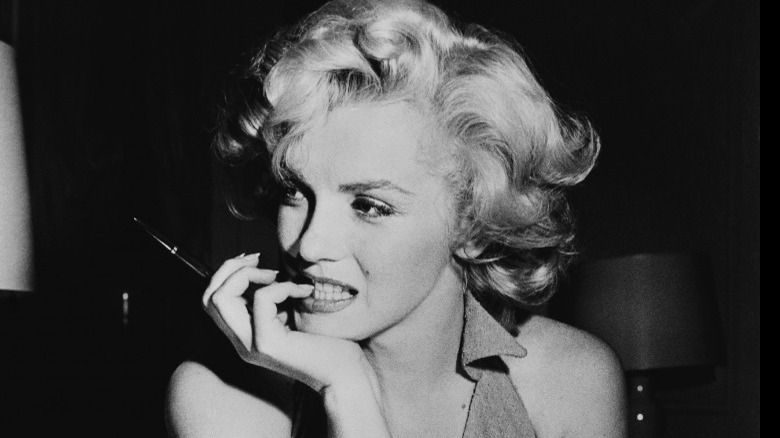
Keystone Features/Getty Images
Ever since he was assassinated on November 22, 1963, JFK's legacy has constantly been subjected to incredibly sensationalized rumors about his private life. The most notorious among them are his alleged affairs with several mistresses. According to People magazine, JFK is suspected of being involved in at least six affairs. Several of them were supposedly with White House staff, including interns and secretaries. Many of the women have claimed the relationships started in the late-1950s or 1960s, when Kennedy would have been either a senator or the president.
Unfortunately, there is not a ton of evidence to support whether or not most, or any, of these affairs ever actually happened. JFK was never given an opportunity to confront his accusers before his death, leaving open the possibility if he would have ever confirmed them or not. However, several Kennedy aides, like Barbara Gamarekian, have validated some suspicions of his various infidelities.
The most famous accusation revolves around an alleged affair he had with actress and superstar Marilyn Monroe in the 1960s. There is also some speculation that his wife, Jaqueline Kennedy, knew about the affairs but tolerated them (via People). Unfortunately, it is likely we will never know the complete truth about Kennedy's private life and whether or not he really had as many affairs as he is accused of.
Rumors about ties to the mob
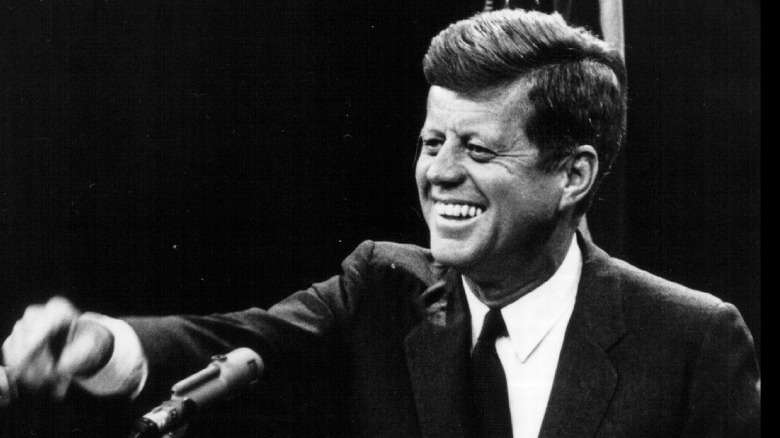
National Archives/Getty Images
Another area of John Kennedy's private life that is rife with speculation is his and his family's alleged ties to mob figures like Sam Giancana and the Chicago Outfit. The rumors go back to the 1960 presidential election and the accusations surrounding ballot stuffing and widespread voter fraud. There are allegations that Kennedy's father contacted Giancana about having the Chicago mob rig the election in his son's favor, in exchange for not prosecuting their various crimes once in office (per the Mob Museum). There are also allegations that Frank Sinatra contacted Giancana on behalf of Kennedy to flip the election for his son. However, none of these allegations have any evidence to support them.
The biggest accusations to connect Kennedy and the mob were made by Judith Campbell Exner in her memoirs. Exner wrote that she had affairs with both Giancana and Kennedy, and that she had tried to introduce them to each other in 1960 to help fix the election (via The Irish Times). However, her stories at times contradicted each other and were vehemently denied by Kennedy's closest aides.
It is true that Kennedy's CIA and Giancana were working together to assassinate Cuban President Fidel Castro. Yet, it was not arranged personally by Kennedy himself, but rather by CIA agents Richard Helms and William Harvey — though Kennedy may have been aware through his brother Robert (via Lawrence Freedman in "Kennedy's Wars").